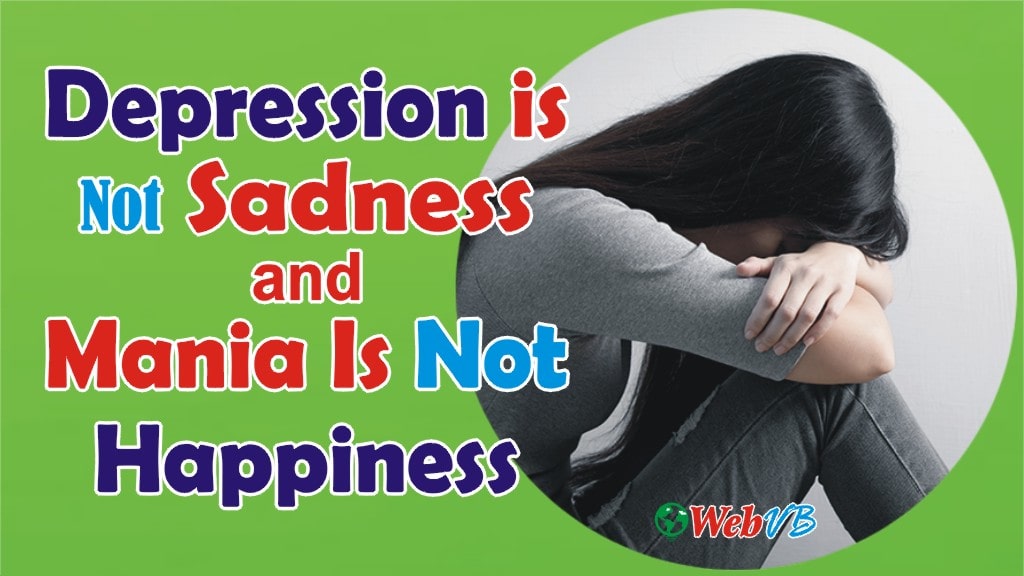Depression and mania are two extremes on the spectrum of mood disorders, often misunderstood as mere intensifications of sadness and happiness, respectively. However, these conditions are far more intricate, involving a complex interplay of biological, psychological, and environmental factors. This article aims to delve into the distinctions between depression and mania, depression and sadness, and mania, and happiness, shedding light on the nuanced nature of mood disorders.
Depression Is Not Sadness and Mania Is Not Happiness
1. Understanding Depression: Beyond Sadness
*Depression, a prevailing mental health concern, extends far beyond the realms of ordinary sadness.* While sadness is a normal emotional response to life's challenges, depression is a persistent and debilitating state that can profoundly impact one's daily life. A crucial distinction lies in the duration, intensity, and functional impairment associated with depression.
*Duration: Sadness is transient, often triggered by specific events, and tends to diminish over time. In contrast, depression persists for extended periods, often lasting weeks, months, or even years.
*Intensity: Sadness is a natural and proportionate emotional response, while depression often involves an overwhelming sense of hopelessness, emptiness, and despair that goes beyond the usual emotional fluctuations.
*Functional Impairment: Depression can disrupt various aspects of daily functioning, affecting one's ability to work, maintain relationships, and engage in activities previously enjoyed. This functional impairment distinguishes clinical depression from regular sadness.
2. The Biological Basis of Depression
Depression is not solely a result of external circumstances; it has a robust biological basis. Neurotransmitters, such as serotonin and dopamine, play a crucial role in regulating mood, and imbalances in these neurotransmitters are often implicated in depressive disorders. Genetic predispositions, hormonal factors, and structural brain abnormalities also contribute to the complex etiology of depression.
3. Mania: Beyond the Facade of Happiness
Mania, a defining feature of bipolar disorder, is often misconstrued as an elevated state of happiness. However, it transcends the bounds of normal happiness and enters a realm of heightened and erratic emotions.
* Intensity: Mania is characterized by an intense euphoria that goes beyond the typical fluctuations of mood. It can result in impulsive and risky behaviors, such as excessive spending, substance abuse, and reckless decision-making.
* Lack of Control: Unlike happiness, which is typically within one's control, mania often involves a loss of control over one's thoughts and actions. This lack of control contributes to the destructive behaviors associated with manic episodes.
* Cyclical Nature: Mania is part of a cyclical pattern in bipolar disorder, alternating with depressive episodes. This cyclical nature distinguishes it from the more stable and enduring experience of happiness.
4. The Neurochemical Rollercoaster of Mania
Similar to depression, mania has a neurobiological basis. An overactivity of neurotransmitters like dopamine is associated with manic episodes. Understanding the neurochemical underpinnings of mania is crucial for developing effective treatments that target the root causes of bipolar disorder.
5. Navigating the Gray Areas: Mixed Episodes and Atypical Presentations
Mood disorders are not always neatly categorized into distinct episodes of depression or mania. Mixed episodes, where symptoms of both depression and mania coexist, blur the lines between these states. Additionally, atypical presentations, such as high-functioning depression or hypomania, further complicate the diagnostic landscape.
6. Holistic Approaches to Treatment
Addressing mood disorders requires a multifaceted approach that goes beyond the conventional dichotomy of medication versus therapy. Integrative interventions, including psychotherapy, lifestyle modifications, and support networks, play a crucial role in managing these conditions. Recognizing the unique needs of each individual and tailoring treatment plans accordingly is essential for fostering long-term well-being.
Conclusion:
In conclusion, depression is not a transient sadness, and mania is not a euphoric state of happiness. Unraveling the complexities of mood disorders involves acknowledging the intricate interplay of biological, psychological, and environmental factors that contribute to these conditions. By understanding the distinctions between normal emotions and clinical states, we can foster empathy, reduce stigma, and pave the way for more effective interventions that address the root causes of mood disorders.












